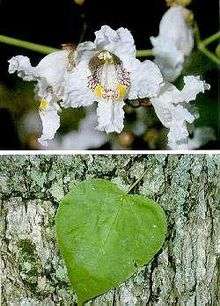Catalpa
| Catalpa | |
|---|---|
 | |
| Catalpa speciosa flowers, leaf and bark | |
| Scientific classification | |
| Kingdom: | Plantae |
| (unranked): | Angiosperms |
| (unranked): | Eudicots |
| (unranked): | Asterids |
| Order: | Lamiales |
| Family: | Bignoniaceae |
| Tribe: | Tecomeae |
| Genus: | Catalpa Scopoli |
| Species | |
Catalpa, commonly called catalpa or catawba, is a genus of flowering plants in the family Bignoniaceae, native to warm temperate and subtropical regions of North America, the Caribbean, and East Asia.
Description
Mostly deciduous trees, they typically grow to 12–18 metres (39–59 ft) tall and 6–12 metres (20–39 ft) wide. A 10-year-old sapling stands about 6 metres (20 ft) tall. They can be recognized by their large, heart-shaped to three-lobed leaves, showy white or yellow flowers in broad panicles. In the autumn they bear 20–50 centimetres (7.9–19.7 in) long fruits that resemble a slender bean pod full of small flat seeds, each with two thin wings to aid in wind dispersal. Because of the leaves, they are sometimes confused with the tung tree (Vernicia fordii) in the southern U.S., or the invasive Paulownia tomentosa from China.
Due to their large leaf size, catalpas are a popular habitat for many birds, providing them good shelter from rain and wind. These trees have few limb droppage, but drop large dark-brown bean pods during late summer. The wood of catalpas is quite soft.[1]
Catalpas begin flowering after roughly 3 years, and produce seed pods after approximately 5 years.
Species
The two North American species, Catalpa bignonioides (southern catalpa) and Catalpa speciosa (northern catalpa), have been widely planted outside their natural ranges as ornamental trees for their showy flowers and attractive shape, or growing habit. Northern and southern catalpas are very similar in appearance, but the northern species has slightly larger leaves, flowers, and bean pods. Flowering starts after 275 growing degree days. Catalpa ovata from China, with pale yellow flowers, is also planted outside its natural range for ornamental purposes.

Etymology
The name derives from the Muscogee name for the tree, "kutuhlpa" meaning "winged head" and is unrelated to the name of the Catawba people.[2][3] The spellings "Catalpa" and Catalpah" were used by Mark Catesby between 1729 and 1732, and Carl Linnaeus published the tree's name as Bignonia catalpa in 1753.[4][5] Giovanni Antonio Scopoli established the genus Catalpa in 1777.
The bean-like seed pod is the origin of the alternative vernacular names Indian bean tree and cigar tree for Catalpa bignonioides and Catalpa speciosa, respectively.
Food source
The tree is the sole source of food for the catalpa sphinx moth (Ceratomia catalpae), the leaves being eaten by the caterpillars. When caterpillars are numerous, infested trees may be completely defoliated. Defoliated catalpas produce new leaves readily, but with multiple generations occurring, new foliage may be consumed by subsequent broods. Severe defoliation over several consecutive years can cause death of trees. Because the caterpillars are an excellent live bait for fishing, some dedicated anglers plant catalpa mini-orchards for their own private source of "catawba-worms", particularly in the southern states.[6]
Other uses
Catalpa is also occasionally used as a tonewood in guitars.
Selected species
- Catalpa bignonioides Walter - southern catalpa
- Catalpa brevipes Urb. -
- Catalpa bungei C.A.Mey. - Manchurian catalpa. Source of "Chu wood".
- Catalpa cassinoides Spreng. -
- Catalpa communis Dum.Cours. -
- Catalpa cordifolia Moench -
- Catalpa denticulata Urb. -
- Catalpa domingensis Urb. -
- Catalpa duclouxii Dode -
- Catalpa ekmaniana Urb. -
- Catalpa fargesii Bur. -
- Catalpa henryi Dode -
- Catalpa heterophylla Dode -
- Catalpa himalayensis Hort. ex Dippel -
- Catalpa hirsuta Spreng. -
- Catalpa kaempferi Siebold & Zucc. -
- Catalpa longisiliqua Cham. -
- Catalpa longissima (Jacq.) Dum.Cours. - Haitian catalpa
- Catalpa macrocarpa Ekman -
- Catalpa microphylla Spreng. -
- Catalpa nana Hort. ex Dippel -
- Catalpa oblongata Urb. & Ekman -
- Catalpa obovata Urb. -
- Catalpa ovata G.Don - Chinese catalpa. Also called the Yellow catalpa from the color of its blossoms. Source of "Chu wood".
- Catalpa pottsii Seem. -
- Catalpa pubescens (Griseb.) Bisse -
- Catalpa pumila Hort. ex Wien. -
- Catalpa punctata Griseb. -
- Catalpa purpurea Griseb. -
- Catalpa silvestrii (Pamp. & Bonati) S.Y.Hu -
- Catalpa speciosa Warder ex Engelm. - northern catalpa
- Catalpa sutchuensis Dode -
- Catalpa ternifolia Cav. -
- Catalpa thunbergii Hort. ex Wien. -
- Catalpa tibetica Forrest -
- Catalpa umbraculifera Hort. -
- Catalpa vestita Diels -
- Catalpa wallichiana Hort. ex Wien. -
References
- ↑ Maroni, Kristi; Sarah Domville (2003-12-04). "Catalpa Tree". Tree Walk. Nazareth College of Rochester. Retrieved 2009-04-30.
- ↑ Gerard, William R. Plant names of Indian origin_II. Garden and Forest. volume 9, no. 436. page 262. (1896).
- ↑ Cassidy, Fred. Lemmatization—The case of "Catalpa". in McIntosh, Language Form and Linguistic Variation: Papers Dedicated to Angus McIntosh. Amsterdam : Benjamins, 1982. Current issues in linguistic theory, 15.
- ↑ Catesby, Mark.The natural history of Carolina, Florida and the Bahama Islands. volume 1. page and plate 49.
- ↑ Linne, Carolus von Linne. Species Plantarum. 1st edition. 1753. volume 2. page 622
- ↑ Hyche, L. L., "The Catalpa Sphinx" Department of Entomology Auburn University, http://www.ag.auburn.edu/enpl/bulletins/catalpasphinx/catalpasphinx.htm Retrieved on 2009, 05-16.
- ↑ "Species Records of Catalpa". ARS, National Genetic Resources Program, GRIN. USDA . Retrieved August 19, 2009.
- ↑ "Plant name details for Catalpa ". IPNI. Retrieved August 19, 2009.
External links
| Wikimedia Commons has media related to Catalpa. |